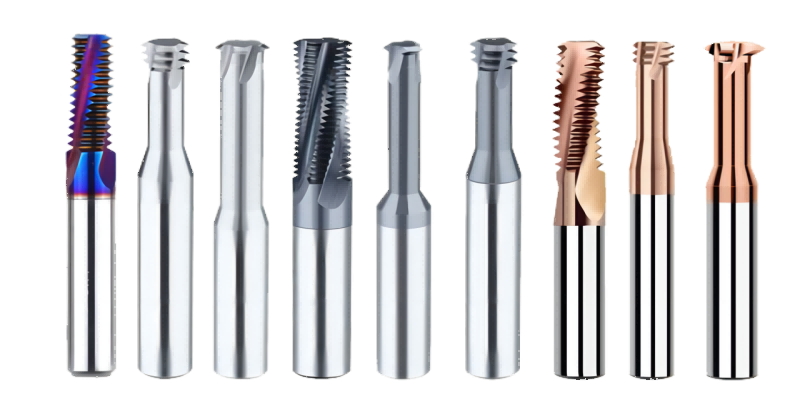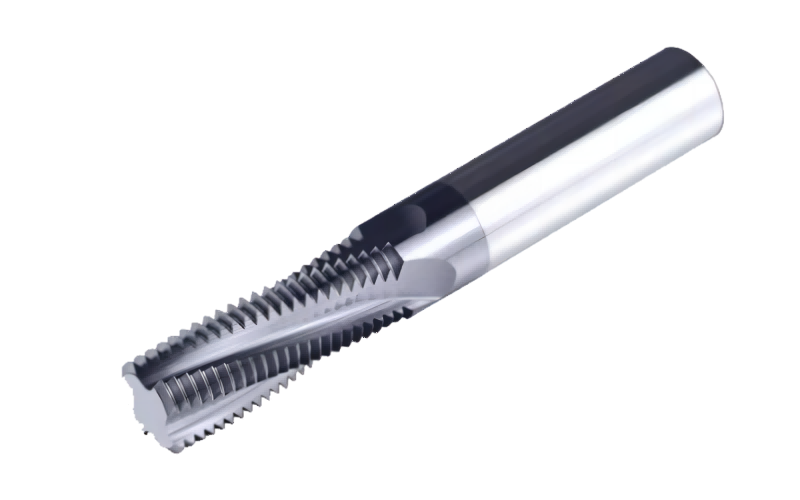Thread milling has many advantages, such as high processing efficiency, high thread quality, good tool versatility, and good processing safety. In practical production applications, good processing results have been achieved.
Advantages of thread milling tools:
1. Thread milling cutter can process threads with different diameters and the same profile
Different threads can be processed using a thread milling cutter by changing the interpolation radius, which can reduce the number of tools, save tool change time, improve efficiency, and facilitate tool management. Additionally, one cutter can process left and right rotation threads. Whether the thread milling cutter processes the thread left-handed or right-handed completely depends on the machining program. For threaded holes with the same pitch and different diameters, using a tap machining requires multiple cutting tools to complete. However, if using a thread milling cutter for machining, using one cutting tool is sufficient.
2. Improvement of thread accuracy and surface quality
Due to the current manufacturing material of thread milling cutters being hard alloy, the machining speed can reach 80-200m/min, while the machining speed of high-speed steel wire cones is only 10-30m/min. Thread milling is completed through high-speed tool rotation and spindle interpolation. Its cutting method is milling, with high cutting speed, resulting in high thread accuracy and surface quality.
3. Convenient internal thread chip removal
Milling thread belongs to chip cutting, with short chips. Additionally, the diameter of the machining tool is smaller than that of the threaded hole, so the chip removal is smooth.
4. Require low machine power
Because thread milling is chip breaking cutting, with local tool contact and low cutting force, the power requirements for the machine tool are relatively low.
5. The reserved depth of the bottom hole is small
For threads that do not allow transition threads or undercut structures, it is difficult to machine using traditional turning methods or tap dies, but it is very easy to achieve CNC milling. Thread milling cutters can process flat bottomed threads.
6. Long tool life
The service life of a thread milling cutter is more than ten or even tens of times that of a tap, and in the process of CNC milling threads, it is extremely convenient to adjust the diameter size of the thread, which is difficult to achieve using a tap or die.
7. Easy to achieve secondary cutting of threads
The reprocessing of existing threads has always been a challenge in using turning to process threads. After using CNC milling of threads, this problem is easily solved. From pure motion analysis, it can be seen that during milling, as long as the feed distance of each turn is fixed and the tool is lowered from a fixed and constant height each time, the processed thread will be in the same position, and the size of the radius will not affect the thread depth (tooth height), so there is no need to worry about tooth disorder.
8. Machinable high hardness materials and high-temperature alloy materials
For example, the thread processing of titanium alloy and nickel based alloy has always been a relatively difficult problem, mainly because high-speed steel wire taps have a shorter tool life when processing the above-mentioned material threads. However, using a hard alloy thread milling cutter for hard material thread processing is an ideal solution, which can process threads of high-temperature alloy materials with a hardness of HRC58-62.
Post time: Jul-17-2023



